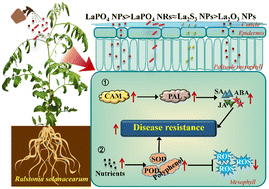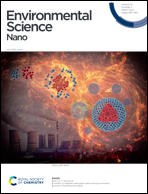Lanthanum-based nanomaterials suppress bacterial wilt in tomato: importance of particle morphology and dissolution profiles†
Abstract
Loss of crop yield to pathogen damage seriously threatens efforts to achieve global food security. In the present work, lanthanum (La) based nanomaterials (NMs) with different morphologies and compositions, including LaPO4 nanorods (NRs, 92.5 × 11.6 nm), LaPO4 nanoparticles (NPs, 110.9 nm), La2S3 NPs (38.6 nm), and La2O3 NPs (55.5 nm), were investigated for their control of bacterial pathogen Ralstonia solanacearum on tomato (Solanum lycopersicum). Foliar application of LaPO4 NRs (50–200 mg L−1) significantly suppressed pathogen infection, with 100 mg L−1 decreasing disease incidence by 71.4% as compared with infected control. At 100 mg L−1, the disease control efficacy of different La based NMs followed the order of LaPO4 NPs > LaPO4 NRs ≈ La2S3 NPs > La2O3 NPs. Additionally, disease suppression efficacy with LaPO4 NPs was 4.6-fold greater than the additive equivalent of La and P ions. Mechanistically, LaPO4 NPs could steadily supply low level La ions to pathogen infected tomatoes to bind and activate calmodulin, with subsequent enhancement of phenylalanine ammonia lyase activity by 88.9%, as well as the upregulation of pathogenesis-related gene (e.g., PR1, PR-P2, and P4) expression by 13.3–742.1%. Additionally, La based NMs amendment enhanced the flavonoid and polyphenol content by 13.7–44.8%, and antioxidative enzyme activity by 11.4–124.3%, decreasing the oxidative stress in tomato shoots by 16.4–25.4%. The higher disease control ability of LaPO4 NPs than other La based NMs was due to its greater bioavailability, slow-release ability, and simultaneous P nutrient supplement. The findings highlight the importance of tuning of nanomaterial morphology and composition to optimize sustainability and efficacy.

- This article is part of the themed collections: Environmental Science: Nano Recent HOT Articles and Nano-bio interactions


 Please wait while we load your content...
Please wait while we load your content...